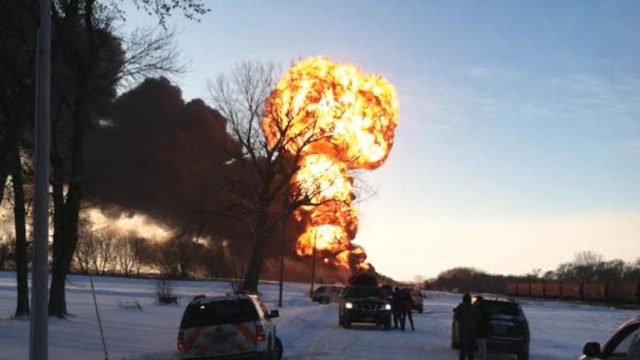It’s Almost Like Building Pipelines Like DAPL Leads to Safer Transportation of Oil or Something

Remember over the last few years when the enemies of oil development were hyping oil train derailments?
To be fair those derailments – some of them hugely explosive and damaging, some even costing people their lives – were a legitimate thing to be concerned about. But when some, including this observer, argued that the solution was to build pipelines the anti-oil folks scoffed.
But now North Dakota has a lot more pipeline capacity on hand, including the recently completed and very controversial Dakota Access Pipeline, and the result has been a decline in oil-by-rail shipments.
“Philadelphia Energy Solutions Inc, the largest refiner on the U.S. East Coast, will not be taking any rail deliveries of North Dakota’s Bakken crude oil in June, a source familiar with delivery schedules said on Tuesday – a sign that the impending start of the Dakota Access Pipeline is upending trade flows,” Reuters reports.
“It’s the new reality,” said Taylor Robinson, president of PLG Consulting, is quoted as saying in the article. “Unless there’s an unforeseen event, like a supply disruption, there will be no economic incentive to rail Bakken to the East Coast.”
But it’s not just the Dakota Access Pipeline. Other, smaller projects have also come online in recent years and have caused oil-by-rail shipments to plummet according to this graph from the North Dakota Pipeline Authority’s April update:
Per the report, as of February of 2017 about 60 percent of North Dakota oil was being put in pipelines compared to just 25 percent hitting the rails:
Just to put an exclamation mark on this data, here’s the trend line for the volume of North Dakota oil shipped by rail:
Before you argue that this decline in oil-by-rail shipments is the result of oil activity falling off in North Dakota amid low prices. That’s a part of it, but nowhere near all of it, because oil production hasn’t fallen off nearly as much as you might think.
The all-time high for North Dakota oil production was over 1.2 million barrels per day in December of 2014. In February of 2017, the last month for which data has been reported, production was more than 1.034 million barrels per day.
By the way, look at that rig count edging back up. It would be foolish to say that we are heading for another boom, but we are seeing a return in oil activity, and the increase availability of pipeline infrastructure is an important part of that recovery.
To be clear, various regulatory agencies and the rail industry itself have taken steps to make oil-by-rail shipments safer. Rail will continue to be one way oil producers get their products to market. And that’s fine.
But increased pipeline capacity, built over the vociferous and sometimes violent objections of environmental activists, has made the transportation of oil out of North Dakota safer overall.
That’s a good thing. And yet another reason why we shouldn’t spend a lot of time listening to the aforementioned activists.








